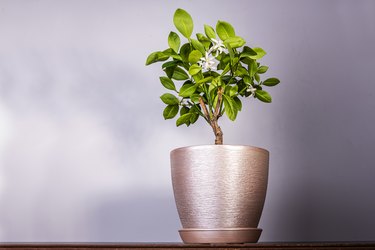
A bonsai tree can make a beautiful and unusual indoor plant feature. You can purchase them ready-made, but if you're feeling creative, it's also possible to make your own bonsai-style tree at home. Although a mature bonsai specimen takes time to become established, creating an "instant" or "starter" bonsai tree is a fun gardening project.
What Is Bonsai?
Video of the Day
A bonsai tree isn't one particular plant species but rather a living art form. According to the Old Farmer's Almanac, it may date back to China during the Han Dynasty of 206 B.C. to A.D. 220, making it an ancient horticultural tradition. Bonsai is a method of pruning, grafting and shaping small trees to intentionally dwarf their growth and make them look miniaturized. You can grow bonsai indoors and outdoors in small, shallow pots, giving the illusion of an older, well-established tree but on a much smaller scale.
Video of the Day
Suitable Bonsai Options
There are many different trees that can become bonsai. Any plant that is a perennial with a woody stem can be a bonsai with the correct type of pruning and confinement to a small pot. Jade plants (Crassula ovata, USDA zones 11-12), junipers (Juniperus spp.), and tea plants (Camellia sinensis, zones 6-9) make popular bonsai for beginners, but selections in many genera, including Ficus, Schefflera, Bougainvillea and Gardenia, can work.
Select your bonsai tree based on your own needs. Think about whether you're planning to keep it indoors or outdoors and the size and shape you desire. You should consider the light source for your bonsai as well in addition to how much time you're willing to spend on its maintenance. You should also select a specimen with a shape that lends itself to the future bonsai appearance you have in mind. You can shape a bonsai by pruning, but it's easier if you start with a shape that's at least vaguely similar.
How to Make a Bonsai Tree
First, select a pot that's suitable for your bonsai needs. Bonsai trees require small pots to deliberately restrict their growth, but you do want to ensure they're deep enough to cover the roots of the tree; otherwise, it may struggle to take in water and nutrients. You also want to ensure there are drainage holes to prevent root rot and that the pot is wide enough to balance your bonsai and prevent it from toppling over.
Once you've selected the right plant for your bonsai, it's time to transplant it to your pot. If you're using a deciduous plant, it's best to transplant in spring since the growing season will help the plant recover from pruning more quickly. Prune the roots of your plant before potting, focusing particularly on any thick or upward-facing roots. Use clean, sharp pruners and make sure to sterilize the blades before use by dipping them in rubbing alcohol to avoid introducing disease to your plant.
Place well-draining potting medium, ideally one that's formulated for bonsai plants, in the base of the pot. Position your bonsai's roots into the center of the pot and maneuver the potting medium to hold the tree in place. Adding some moss or gravel to the top of the bonsai soil can add an aesthetic touch and may help hold your tree in place.
This process may be somewhat traumatic for your plant, so after you've potted your bonsai plant, you must take good care of it. Place it out of direct, harsh sunlight for the first few weeks. Keep the soil moist by watering thoroughly whenever the surface begins to feel dry, though make sure any excess water can drain. Wait until the tree has established itself before applying any fertilizer.